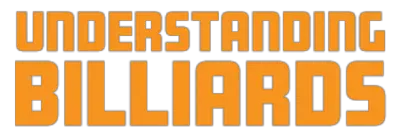If you are reading this then you are looking for tips on how to become a better player and look no further because I have put together a list of tips that will help you improve your game faster. The truth of the matter is that you never stop learning when playing billiards, every game you play, every shot you take you are learning from. This way of learning can be fast or slow depending on what and when you figure something out, but what if I can give you a few insider tips on what I’ve learned over my life time so far playing pool.
I know some of you don’t want to read this long article of tips, even though you should, I went ahead and summarized the list into these few tips to help you improve your skills on the table. These tips include proper fundamentals (stance, stroke, grip, bridge), planning shots ahead, cue ball control, getting a grip on your nerves in a match, and the best practice drills for you to work on.
Are you tired of missing those easy shots? Are you ready to become a better billiards player? Let me teach you what I have learned over the years playing in and out of leagues and tournaments to help you become the best player you can be.
Proper Fundamentals
To become a consistent player, you need to understand the basics or proper fundamentals of your stance, stroke, grip, and bridge. You will want to be able to line up your shot and hit the cue ball exactly where you intend to every single time and the only way to do this is to perfect your fundamentals.
The biggest key to understand when it comes to the fundamentals is to try to keep a minimum of moving body parts. The more movement your body is doing the more risk of something going wrong. Once you are ready for your shot your body should be a statue the only movement will be from your elbow down to your wrist in a straight line from a 90-degree angle to your nipple or armpit area.
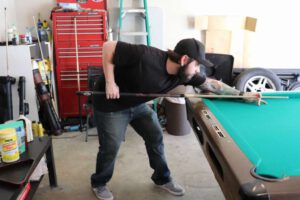
Stance
Before we can talk about the stroke, we need to address the stance. Your stance needs to be balanced and depending on your height will affect how wide of a stance is needed. Your back foot needs to be on the shooting line. Pay attention and make sure you understand what the shooting line is because I will be referring to it throughout this article. Imagine a line runs through the object ball and the cue ball and down onto the ground that is how you will line up your back foot for every shot.
Your front foot will be placed just outside of the imaginary line no wider than your shoulders width. This will allow you to be aligned up properly and have a stable and balanced stance. Next will be to align your chin with the shooting line before laying your bridge hand down onto the table. This will prevent yourself from putting your hand into a bad position ultimately affecting your shot alignment. Line your chin up then lay your hand down onto that line.
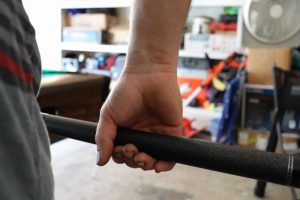
Grip
Your grip on the end of the cue should be loose and not tight. I see a lot of player make this mistake they will start off with a loose grip the in their back stroke the grab it tightly thinking it will get the shot more control and that is not true. When you try to control the stroke with your grip hand you are more likely to jar the cue off your shooting line and potentially miss your shot.
You should just rest the cue with your back hand, only hold onto the cue with your thumb and index finger, let the cue just rest on the other fingers. Your thumb should be pointed at the ground and not down the length of the cue. You will need to make sure that your wrist is hanging straight down and not slightly holding the cue to the side of the shooting line because that will affect your stroke.
The only exception with having a loose grip for your shots is for masse and jump shots those you will want to have a tighter grip to get more action onto the ball.
Bridge
A bridge is what you rest the cue on when you take a shot. The bridge hand is the hand that you rest the cue on to guide and align the tip of your cue to where you want to contact the cue ball. The main focus of a bridge is to be a sturdy platform that you can guide your cue across. So, keeping that in mind, you will want to make sure your bridge always has at least three points of contact with the table to be as stable as possible.
Most people use their hands for the bridge, but every now and then you will be in a position that you just can’t reach, especially on larger tables, that is when you will use a mechanical bridge. There are several different types of bridges and they all have their specific use. The bridge types are open bridge, closed bridge, mechanical bridge, as well as bridges for shooting over a ball, and shooting on the rail.
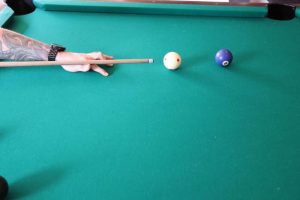
Open Bridge
The open bridge or sometimes called the open-handed bridge is the easiest to learn and use for most people so that is where we are going to start. To set up your hand for an open bridge, lay your hand flat on the table and spread your fingers apart. Hold your thumb up to your index finger’s knuckle to where you are creating a “V” shape for your cue to slide through.
This bridge is great for beginners because it is easier to learn and quicker to set up. With the top of the cue not covered by your finger it allows the cue to slide across your hand with less friction but there are some disadvantages to this bridge set up. This bridge should only be used when you have a long reach to your shot, or you are just hitting the center of the cue ball. If your shot requires more speed, power, or English (spin) such as a follow or draw shot, you should be using closed bridge instead.
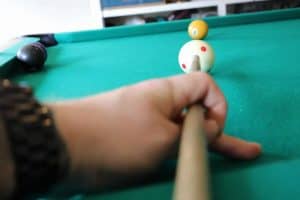
Closed Bridge
The closed bridge or sometimes called the closed-handed bridge is what you will see more experienced players using more often than an open bridge. This bridge setup is best for when you are applying English or spin on the cue ball as well as for more powerful shots. This bridge type will help to keep the cue aligned with the shot and will help to prevent a miscue.
This bridge is similar to the open bridge. To get started, lay your palm flat on the table and spread your fingers apart creating a sturdy base. The difference is instead of creating a “V” shape with your thumb, you will be wrapping your index finger around the cue tightly but not too tight that you can’t slide your cue through. Your thumb should be underneath the cue.
This may feel a little uncomfortable at first but through repetition you will get use to it. Whenever possible I recommend using this bridge because of its ability to better control the alignment of the shot and help to prevent miscue when applying spin or on more powerful shots.
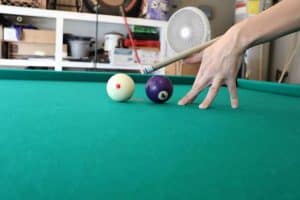
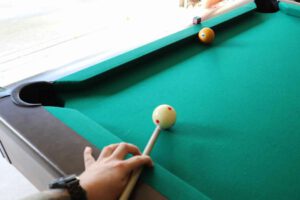
Over-A-Ball Bridge & On-the-Rail Bridge
When you are in a game sometimes you may find that the cue ball lays too close to another ball or the rails of the table that you cannot lay your palm down to create a sturdy bridge. I see some players just try to hold their bridge hand in the air, as if that was ever a good idea, which will not work as you hand is just floating in the air and can move at any time during your stroke.
If your cue ball is too close to another ball to use an open bridge or closed bridge, what you need to do is create a tripod bridge with your hand so that you will have a sturdy base and be able to shoot over another ball. There are a few varieties of ways to do this but there are two that I find the easiest.
- Lay your finger tips onto the table, slide your index and pinky fingers back leaving your middle and ring fingers together creating a tripod, and hold your thumb up to your index knuckle like you would for and open hand bridge creating the “V” shape for your cue to slide through.
- Another common way to make a tripod shape is to create “Devil Horns” with your hand or the rock n roll hand gesture whatever you want to call it. Lay your fingertips down onto the table, let your middle and ring fingers drop down, creating a tripod, and again hold your thumb up to your index knuckle creating the “V” for your cue to slide through.
Those tripod bridges are great for shooting over a ball when the cue ball lays to close to another ball, but what about when the cue ball is laying on the rail. When the cue ball is on the rail it can be a little intimidating considering the rail covers half the ball making hitting the center of the cue ball hard.
Depending on what you are needing to do you may be able to hit the cue ball above center putting a little bit of follow on the cue ball. A good way to do the is to lay you cue onto the rail and put your hand on top of the cue. Take your thumb and touch your middle finger’s middle knuckle, this will create a guide for you to lay your cue next to. Then wrap your index finger around the cue keeping it secured up next to your thumb.
***Note: That is great but sometimes you need to hit the cue ball center, you are not able to put follow on the shot for whatever the reason and that is possible as well. To do that you will need to elevate the cue slightly the achieve a center hit so for your bridge I recommend a closed bridge on top of the rail but slide your middle finger closer to you making your cue elevate more then strike down into the center of the cue ball.
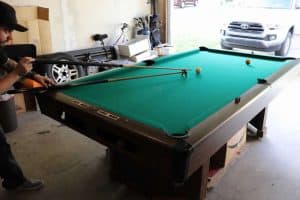
Mechanical Bridge
The mechanical bridge can be very helpful as long as you know how to correctly use it, You will probably hear most amateur players say they hate using it but that is because they are not using it properly. Just like anything else you cannot expect to be good at something without practice. Many players never practice using a mechanical bridge then when they find themselves having to use it, they cannot.
The proper way to use a mechanical bridge is to put it close to the cue ball like you would do with any other bridge, then lay the bridge down on the table before shooting, don’t hold onto it. This is a mistake I see all the time from players. By not holding onto the bridge when shooting will prevent you from moving the bridge while you are making your shot. I recommend laying your hand on top of the bridge so after your shot your will be able to quickly pick it up off the table but don’t hold it while you are shooting.
I hold the cue like I was getting ready to throw a dart but keep the cue lined up with my chin on the shooting line as I would normally do. Try to keep the cue as level as the shot allows for without too much elevation and follow through your stroke like a normal shot, don’t just jab at the ball.
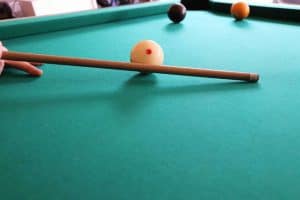
Stroke
Ah, finally the stroke, one of the most important fundamentals to get right to become a better and more consistent player. It is not difficult to learn but will take a lot of practice to perfect.
A good stroke requires a combination of a sturdy bridge hand, loose grip, and good posture. You don’t want any unnecessary movements. You will want to try and keep the cue as level to the table as the shot will permit. Try to keep your shoulder from moving or dropping down during your stroke. The only movement should be from your elbow down swinging like a pendulum.
When you are setting up for your shot your shoulder should be on the imaginary shooting line that we talked about earlier. Your elbow should be at a 90-degree angle at the contact point of the tip of the cue and the cue ball. Your back swing should be slow with your follow through swift. Make sure to follow all the way through the shot and finish your stroke. When you finish your stroke the tip of your cue should hit the felt, do not start to stand up before this happens, or else you risk the tip of the cue going lower affecting the outcome of your shot.
When you finish your stroke, your shoulder should still be on the shooting line and should have not moved but your grip hand should be near your armpit or nipple area. Make sure during your stroke your wrist is hanging straight down and does not twist or anything during the stroke.
***Note: Something to remember, the more moving parts during your stroke the more chances for something to go wrong. So, keep your movements to a minimum.
Planning Your Shots
No matter which billiard game you are playing, it is a strategy game. Many new players do not grasp how complex this game can get with strategy. They think well obviously the player who can make more successful shots will be the winner. While that is correct, once you start leveling up your skill set making a ball, no matter where on the table, is quite simple once you have mastered the fundamentals.
So, as you advance your skills so will your competition, so it will be no longer a matter of who the better shot is but rather who can strategize better. It becomes of game of offense shots and defense shots and knowing when to do which can make or break the game.
Offense Vs Defense
To help get a better understanding lets compare billiards to a game of American football. In American football there is an offense, whose purpose is to score a touchdown, and there is a defense whose purpose is to prevent the other team from scoring. It is the same for billiards, when you are shooting to make a ball it is an offensive shot and if you are shooting to hide the ball from your opponent or make their shot harder it is considered a defense or safety shot.
Sometimes you will be able to play an offense and defense shot at the same time. When this option is available you should take full advantage of it. So, you are probably wondering how you play both at the same time. Well if you have a shot that you are worried you may miss but you see a position you could leave the cue ball that will leave yourself a shot if you make it but hide a shot for your opponent if you miss. These types of shots come up all the time, but you have to pay attention and look for them because these are great.
For example, let us take the popular billiards game of 8-ball, which has 15 balls, 7 striped, 7 solids, and an 8-ball. Player one must hit all 7 solids in the pocket, and player two must hit all 7 stripes before they can knock the 8-ball in to win the game. If a foul is committed, the opponent is given ball-in-hand, which means they can put the cue ball anywhere on the table.
Let us say player one starts the game off and knocks 3 striped balls in on the break, followed by 2 more before missing, leaving 2 more striped balls on the table. These 2 remaining striped balls are clustered up next to 2 solid balls. Now player two has got to play smart he/she is already down 5 balls, knowing that player one’s last 2 balls are clustered up, he/she should not mess with those balls.
So, a good strategy is to look at all the shots on the table and try to figure out which shots can easily be made and get position to the next without interacting with the cluster. That way player two can make a shot or two then play safe or a defense shot. This defense shot will hide the cue ball behind one of player two’s balls and make player one have to try to kick off a rail to make a good hit on one of their balls, and if they miss player two will get ball in hand giving them a upper hand in the game.
Any great player will tell you the importance of knowing when to play an offense shot and a defensive shot. Some things to consider before deciding which shot to make, how good is your opponent (if you never played, pretend they are better than you, never underestimate you opponent), are there any cluster of balls, any trouble areas on the table, how many balls are left on the table, is there a good defense option. I’m going to break down some suggestions on when to take each, know that other factors can come into play, but I recommend these as a base to get you thinking.
When to play offense:
- You have an easy shot and can easily get in position for your next shot.
- Table is wide open with no trouble areas.
- You feel confident in your ability to not miss.
When to play defense:
- Your opponent is better than you.
- You don’t have an offense shot.
- If your defense option is better than a risky offense.
- If there are trouble areas on the table affecting you ability to run out the table.
Plan 3 Shots Ahead
No professional player plays one shot at a time, they know multiple shots ahead so they can plan where the cue ball needs to be to get shape for the next shot and so on. Planning your shots ahead of time is the only way to truly start running racks.
Does this mean you need to plan every shot out before you make your first shot? No, Things change throughout the game, the position you planned for the cue ball might not have ended up in right place or something else could affect your run. You will always be adapting to where the balls are, so I recommend only planning 3 shots ahead at a time.
To give you an example that I can break down, lets talk about a game of 9-ball. The game of 9-ball is simple, you have 9 balls, numbered 1-9, they must be played in order from lowest to highest with the 9 ball being the game winning ball. So for this example, we broke and made the 1-ball, now we need to look at the next 3 balls to plan out which are the 2-ball, 3-ball, and 4-ball. So, to do this let’s start with the 4-ball and work our way back to the 2-ball.
First, I need to decide which pockets the 4-ball will go in so I can figure out where I need to position the cue ball after making the 3-ball. Then repeat this all the way back to the 2-ball. Now you know where to pocket each ball and where you need the cue ball to be to set up the following shot. After you make your shot on the 2-ball and get your position for the 3-ball re-evaluate make sure your strategy still works. Now, look at the 5-ball see where you want to pocket it and where the cue ball will need to be after making the 4-ball to give you the best shot. Now make the 3-ball and repeat this after every shot until you have made all the balls.
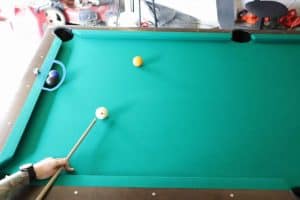
Look for Trouble Areas
Trouble areas on a pool table can mean a few different things such as balls clustered together or in a tough position, like frozen on the rail right beside the side pocket. These areas on the pool table are things to consider before making a shot. How are you going to address these trouble areas? If it is a cluster of balls can you make one of your shots with enough power to send the cue ball off the object ball and off a rail to come break up the cluster.
Cue Ball Control
Being able to control where the cue ball rolls after contacting your object ball is the only way to truly exceed in this game. If you have a delicate shot that you only have a few inches of clearance in order to make your next shot, you need to be able to get your cue ball in that exact position. There are many ways to control the cue ball such as using the rails, using English or spin on the cue ball, and how hard the cue ball is struck.
One of the easiest ways to control the cue ball is to use the rails to move the cue ball around the table. If you have ever watched the professionals play you will notice that they always try to get an angle on every shot and not be straight in. Even though straight in may seem to be an easier shot it makes it harder to move the cue ball around the table. With a straight in shot all you can do is move the cue ball forward, bring the cue ball back, or stop the cue ball. Having and angle gives the shooter options for how to make the shot and where to put the cue ball for the next shot.
Putting English or spin on the cue ball is another popular way to control where the cue ball goes. English is a very complicated subject with so many variable factors that I cannot get too in depth in this article. The spin on the cue ball depending the direction of the spin can affect how the cue ball reacts, off the cue, off the object ball, and off the rails. The variable factors include, where the tip hits the cue ball, size of the tip, speed at which it was struck, and the power of the stroke.
The art of the soft touch, every new player I have ever seen has this problem, they do not know how to hit the cue ball softly. This style of playing can take you far in billiards. For one, if you only hit the cue ball as hard as the shot requires, you are more able to know exactly where the cue ball is going to end up which makes planning your shots ahead much easier. Yes, sometimes a hard hit is required for shots but must of the time a soft hit is all that is needed.
Another reason for hitting soft is you are more likely to make contact in the intended contact area of the cue ball, it also allows you some pocket flexibility for making shots, you can be off the center of the pocket or sometimes even graze the rail and still be able to pocket the ball when the ball is hit softly. Hitting the cue ball harder than what is required is never a good idea because of the lack of control and the possibly of rattling out of a pocket.
Handling Your Nerves
Many players are unaware of how their nerves can affect their performance in a game. Which most of the time people play for fun and don’t take it so seriously which is great but when it comes down to competing that is a different story altogether. To challenge yourself and actually improve your skills on the table you need to play people who are good or even better than yourself.
You can learn a lot from playing higher quality players than yourself by watching them and their strategy of what shots they take and how the move to cue ball around the table. Playing in leagues and in tournaments are a great way to find these players. When playing in a competitive way like this sometimes your nerves can start take over, you may find yourself getting jittery, rushing shots and missing shots you never miss, and really just defeating yourself.
This happens to everyone and it is just part of the learning process when it comes to competitive play. When you are faced with an opponent that you have never played before and they start running the table on you before you even have a chance up at the table it can be nerve racking to say the least. Here are some tips I find helpful.
- When you are not shooting put down your cue don’t hold on to it while your opponent is shooting. I know this may sound odd but holding onto your cue while watching your opponent can increase your stress during a game. Just sit back and relax while you await your next turn on the table.
- Take a pause between every shot that you make, I see a lot of players lining up the next shot before the cue ball has even stopped rolling. For one, that can affect your alignment with the shot if you have already aligned your stance with a shot and the cue ball moves even if it is only a few centimeters. That is enough to alter the aim just enough to miss your next shot. The second reason for the pause is it gives you just enough time to evaluate your situation on the table and allows you a second to rethink your strategy and see if there is any better alternative shots.
- Sometimes when you get down and are about to make your shot and you begin to second guess yourself, stand up and back away from the table, you are second guessing yourself for a reason. Re-evaluate and realign before you shoot.
- Don’t beat yourself up if you miss a shot! It happens it is part of the game. If you miss a shot instantly forget that it even happened otherwise it can haunt you throughout the rest of the game. I see players get so mad at themselves and it ruins their ability to think clearly and play confidently.
- Control how many practice strokes you have before a shot, too many and you start to apply unnecessary pressure onto yourself. Three to five practice strokes are all that is needed to make sure you are aligned up properly and you are going to hit the cue ball where you want to.
How to Practice
I am sure everyone has heard the phrase “Practice makes perfect”, while that is true some ways to practice are much better than others. When you practice you want to make sure you are getting the most out of it. Just playing to play will only get you so far. The best way to practice is to be goal oriented. What are you trying to learn or improve upon? Be specific, break down what need to work on and then practice that one thing.
Lets say that you have been struggling on rail shots, running the object ball down the rail into a corner pocket. Well you shouldn’t just play a game and hope that those shots come up. Take all 15 balls and shot this shot over and over again switching to different sides of the table until you feel completely comfortable with those shots. That is meaningful practice.
Another way to have a meaningful practice is to run drills, there are all kinds of practice drills to work on. These will help you with the pocketing of balls, controlling the cue ball, and working on how hard you hit the balls. There are also drills for learning the rails and how the cue ball navigates them.
By far the most important that I have came to realization with over the years is to always take the game seriously. Every time I play a game of billiards against someone, I pretend I’m in a tournament against a professional, I do not want to underestimate my opponent, and I always want to challenge myself. This does two things, it applies pressure to the game which will train you for the pressure that comes with competing in tournaments, and two, it makes you think and strategize, and the only way to improve on your strategy is to do it repeatedly.
Also, do not always play people who are worse than you, if you are always the best player then you will never improve. You are not only practicing your fundamentals, but you are preparing for how you will react in a tournament setting, emotionally and mentally. Sometimes you may need a little more motivation to get some pressure on the games, and a way to do this is to gamble some money with your opponent on the game. Competing in local tournaments or pool leagues is another great way to find higher quality opponents.
I hope you all the best with these tips and remember the only way to improve is to practice and practice and more practice. But with all that said you still need to have fun too. Happy shooting!




